List of vice presidents of India
The Vice President of India is the second highest constitutional office in the Government of India after the President. In accordance with Article 65 of the Constitution of India, the vice president discharges the functions of the president when a contingency arises due to the resignation, removal, death, impeachment or the inability of the president to discharge their functions. They are also the ex officio chairperson of the Rajya Sabha, the upper house of the Parliament of India.[1][2]
 |
|---|
| This article is part of a series on the politics and government of India |
|
|
The vice president is elected by an electoral college consisting of all the members of both houses of the Parliament in accordance with the system of proportional representation by means of the single transferable vote via a secret ballot conducted by the Election Commission of India. Once elected the vice president continues in office for a five-year term, but can continue in office irrespective of the expiry of the term, until a successor assumes office.[3] They can be removed by a resolution passed by an effective majority in the Rajya Sabha.[4] They are responsible for the protection of the rights and privileges of the members of the Council of States. They also decide whether a bill introduced in the Rajya Sabha is a financial bill or not.[1]
There have been 13 vice presidents since the inception of the post in 1950. The first vice president of India, Sarvepalli Radhakrishnan, took oath at Rashtrapati Bhavan on 13 May 1952.[5] He later served as the president.[6] Following the death of Zakir Husain in 1969, V. V. Giri resigned from the post of vice president to contest the presidential election and got elected.[7] Out of 13 vice presidents, six of them later went on to become the president.[7] Krishna Kant has been the only one to die during his tenure.[8] On 11 August 2017, Venkaiah Naidu was sworn in as the 13th vice president of India.[9]
Vice presidents of India
This list is numbered based on vice presidents elected after winning an Indian Vice Presidential election. The Vice President of India does not represent any political party. The colours used in the table indicate the following:
- Colour key
- Key
- † Died in office
| No. | Name (birth–death)[10] |
Portrait | Elected (% votes) |
Took office | Left office | Term (in years) | President(s) | Party | |
|---|---|---|---|---|---|---|---|---|---|
| 1 | Sarvepalli Radhakrishnan (1888–1975) |
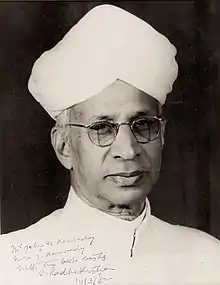 |
1952 (Unopposed) |
13 May 1952 | 12 May 1957 | 10 | Rajendra Prasad | Independent | |
| 1957 (Unopposed) |
13 May 1957 | 12 May 1962 | |||||||
| 2 | Zakir Husain (1897–1969) |
.jpg.webp) |
1962 (97.59) |
13 May 1962 | 12 May 1967 | 5 | Sarvepalli Radhakrishnan | Independent | |
| 3 | V. V. Giri (1894–1980) |
.jpg.webp) |
1967 (71.45) |
13 May 1967 | 3 May 1969 | 2 | Zakir Husain | Independent | |
| 4 | Gopal Swarup Pathak (1896–1982) |
1969 (49.9) |
31 August 1969 | 30 August 1974 | 5 | V. V. Giri (1969–1974) Fakhruddin Ali Ahmed (1974) |
Independent | ||
| 5 | B. D. Jatti (1912–2002) |
.png.webp) |
1974 (78.70) |
31 August 1974 | 30 August 1979 | 5 | Fakhruddin Ali Ahmed (1974–1977) Neelam Sanjiva Reddy (1977–1979) |
Indian National Congress | |
| 6 | Mohammad Hidayatullah (1905–1992) |
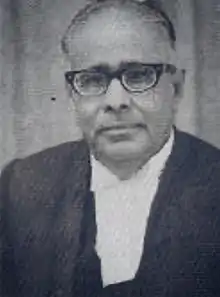 |
1979 (Unopposed) |
31 August 1979 | 30 August 1984 | 5 | Neelam Sanjiva Reddy (1979–1982) Zail Singh (1982–1984) |
Independent | |
| 7 | Ramaswamy Venkataraman (1910–2009) |
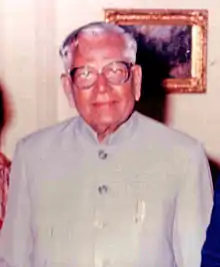 |
1984 (71.05) |
31 August 1984 | 24 July 1987 | 3 | Zail Singh | Indian National Congress | |
| 8 | Shankar Dayal Sharma (1918–1999) |
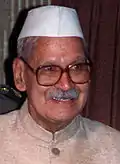 |
1987 (Unopposed) |
3 September 1987 | 24 July 1992 | 5 | Ramaswamy Venkataraman | Indian National Congress | |
| 9 | K. R. Narayanan (1921–2005) |
.jpg.webp) |
1992 (99.86) |
21 August 1992 | 24 July 1997 | 5 | Shankar Dayal Sharma | Indian National Congress | |
| 10 | Krishan Kant (1927–2002) |
.jpg.webp) |
1997 (61.76) |
21 August 1997 | 27 July 2002 | 5 | K. R. Narayanan (1997–2002) A. P. J. Abdul Kalam (2002) |
Janata Dal | |
| 11 | Bhairon Singh Shekhawat (1924–2010) |
 |
2002 (59.82) |
19 August 2002 | 21 July 2007 | 5 | A. P. J. Abdul Kalam | Bharatiya Janata Party | |
| 12 | Mohammad Hamid Ansari (1937–) |
 |
2007 (60.51) |
11 August 2007 | 11 August 2012 | 10 | Pratibha Patil (2007–2012) Pranab Mukherjee (2012–2017) Ram Nath Kovind (2017) |
Indian National Congress | |
| 2012 (67.31) |
11 August 2012 | 11 August 2017 | |||||||
| 13 | Venkaiah Naidu (1949–) |
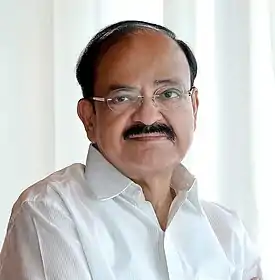 |
2017 (67.89) |
11 August 2017 | Incumbent | 3 years, 176 days | Ram Nath Kovind | Bharatiya Janata Party | |
- Timeline

See also
References
- "Powers and responsibilities of Vice President of India". News Nation. 17 July 2017. Retrieved 2 March 2019.
- Jha, Jitesh (8 August 2017). "Fact Box: Vice President of India". Dainik Jagran. Archived from the original on 5 December 2017. Retrieved 2 March 2019.
- Relhan, Vibhor (5 August 2017). "Following the elections of the Vice President of India". PRS Legislative Research. Retrieved 2 March 2019.
- "The Upper House of Indian Parliament". Rajya Sabha. Archived from the original on 7 April 2018. Retrieved 2 March 2019.
- "From Sarvepalli Radhakrishnan to Venkaiah Naidu: All the Vice Presidents of India". The Times of India. 5 August 2017. Archived from the original on 11 September 2017. Retrieved 2 March 2019.
- Greenhouse, Linda (17 April 1975). "Radhakrishnan of India, Philosopher, Dead at 86". The New York Times. Archived from the original on 12 December 2018. Retrieved 2 March 2019.
- "Venkaiah Naidu vs Gopalkrishna Gandhi: 6 vice-presidents who went on to become presidents". India Today. 18 July 2017. Retrieved 2 March 2019.
- Jafri, Syed Amin (27 July 2002). "Krishan Kant is first vice-president to die in office". Rediff.com. Archived from the original on 16 December 2018. Retrieved 2 March 2019.
- "Venkaiah Naidu sworn in as Vice-President". The Hindu. 11 August 2017. Archived from the original on 9 February 2014. Retrieved 14 January 2018.
- "Former Vice Presidents". Vice President of India. Archived from the original on 30 August 2018. Retrieved 2 March 2019.
